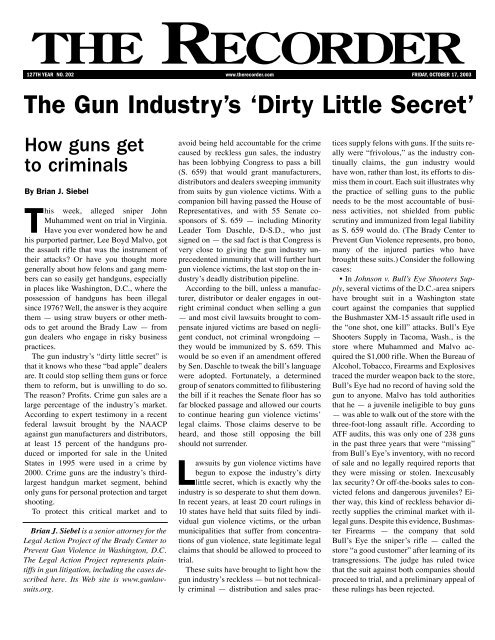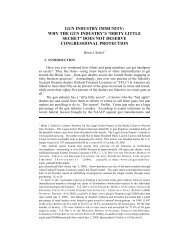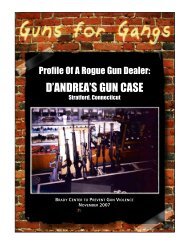The Gun Industry's 'Dirty Little Secret' - Brady Campaign to Prevent ...
The Gun Industry's 'Dirty Little Secret' - Brady Campaign to Prevent ...
The Gun Industry's 'Dirty Little Secret' - Brady Campaign to Prevent ...
- No tags were found...
Create successful ePaper yourself
Turn your PDF publications into a flip-book with our unique Google optimized e-Paper software.
127TH YEAR NO. 202 www.therecorder.com FRIDAY, OCTOBER 17, 2003<strong>The</strong> <strong>Gun</strong> Industry’s ‘Dirty <strong>Little</strong> Secret’How guns get<strong>to</strong> criminalsBy Brian J. SiebelThis week, alleged sniper JohnMuhammed went on trial in Virginia.Have you ever wondered how he andhis purported partner, Lee Boyd Malvo, gotthe assault rifle that was the instrument oftheir attacks? Or have you thought moregenerally about how felons and gang memberscan so easily get handguns, especiallyin places like Washing<strong>to</strong>n, D.C., where thepossession of handguns has been illegalsince 1976? Well, the answer is they acquirethem — using straw buyers or other methods<strong>to</strong> get around the <strong>Brady</strong> Law — fromgun dealers who engage in risky businesspractices.<strong>The</strong> gun industry’s “dirty little secret” isthat it knows who these “bad apple” dealersare. It could s<strong>to</strong>p selling them guns or forcethem <strong>to</strong> reform, but is unwilling <strong>to</strong> do so.<strong>The</strong> reason? Profits. Crime gun sales are alarge percentage of the industry’s market.According <strong>to</strong> expert testimony in a recentfederal lawsuit brought by the NAACPagainst gun manufacturers and distribu<strong>to</strong>rs,at least 15 percent of the handguns producedor imported for sale in the UnitedStates in 1995 were used in a crime by2000. Crime guns are the industry’s thirdlargesthandgun market segment, behindonly guns for personal protection and targetshooting.To protect this critical market and <strong>to</strong>Brian J. Siebel is a senior at<strong>to</strong>rney for theLegal Action Project of the <strong>Brady</strong> Center <strong>to</strong><strong>Prevent</strong> <strong>Gun</strong> Violence in Washing<strong>to</strong>n, D.C.<strong>The</strong> Legal Action Project represents plaintiffsin gun litigation, including the cases describedhere. Its Web site is www.gunlawsuits.org.avoid being held accountable for the crimecaused by reckless gun sales, the industryhas been lobbying Congress <strong>to</strong> pass a bill(S. 659) that would grant manufacturers,distribu<strong>to</strong>rs and dealers sweeping immunityfrom suits by gun violence victims. With acompanion bill having passed the House ofRepresentatives, and with 55 Senate cosponsorsof S. 659 — including MinorityLeader Tom Daschle, D-S.D., who justsigned on — the sad fact is that Congress isvery close <strong>to</strong> giving the gun industry unprecedentedimmunity that will further hurtgun violence victims, the last s<strong>to</strong>p on the industry’sdeadly distribution pipeline.According <strong>to</strong> the bill, unless a manufacturer,distribu<strong>to</strong>r or dealer engages in outrightcriminal conduct when selling a gun— and most civil lawsuits brought <strong>to</strong> compensateinjured victims are based on negligentconduct, not criminal wrongdoing —they would be immunized by S. 659. Thiswould be so even if an amendment offeredby Sen. Daschle <strong>to</strong> tweak the bill’s languagewere adopted. Fortunately, a determinedgroup of sena<strong>to</strong>rs committed <strong>to</strong> filibusteringthe bill if it reaches the Senate floor has sofar blocked passage and allowed our courts<strong>to</strong> continue hearing gun violence victims’legal claims. Those claims deserve <strong>to</strong> beheard, and those still opposing the billshould not surrender.Lawsuits by gun violence victims havebegun <strong>to</strong> expose the industry’s dirtylittle secret, which is exactly why theindustry is so desperate <strong>to</strong> shut them down.In recent years, at least 20 court rulings in10 states have held that suits filed by individualgun violence victims, or the urbanmunicipalities that suffer from concentrationsof gun violence, state legitimate legalclaims that should be allowed <strong>to</strong> proceed <strong>to</strong>trial.<strong>The</strong>se suits have brought <strong>to</strong> light how thegun industry’s reckless — but not technicallycriminal — distribution and sales practicessupply felons with guns. If the suits reallywere “frivolous,” as the industry continuallyclaims, the gun industry wouldhave won, rather than lost, its efforts <strong>to</strong> dismissthem in court. Each suit illustrates whythe practice of selling guns <strong>to</strong> the publicneeds <strong>to</strong> be the most accountable of businessactivities, not shielded from publicscrutiny and immunized from legal liabilityas S. 659 would do. (<strong>The</strong> <strong>Brady</strong> Center <strong>to</strong><strong>Prevent</strong> <strong>Gun</strong> Violence represents, pro bono,many of the injured parties who havebrought these suits.) Consider the followingcases:• In Johnson v. Bull’s Eye Shooters Supply,several victims of the D.C.-area snipershave brought suit in a Washing<strong>to</strong>n statecourt against the companies that suppliedthe Bushmaster XM-15 assault rifle used inthe “one shot, one kill” attacks. Bull’s EyeShooters Supply in Tacoma, Wash., is thes<strong>to</strong>re where Muhammed and Malvo acquiredthe $1,000 rifle. When the Bureau ofAlcohol, Tobacco, Firearms and Explosivestraced the murder weapon back <strong>to</strong> the s<strong>to</strong>re,Bull’s Eye had no record of having sold thegun <strong>to</strong> anyone. Malvo has <strong>to</strong>ld authoritiesthat he — a juvenile ineligible <strong>to</strong> buy guns— was able <strong>to</strong> walk out of the s<strong>to</strong>re with thethree-foot-long assault rifle. According <strong>to</strong>ATF audits, this was only one of 238 gunsin the past three years that were “missing”from Bull’s Eye’s inven<strong>to</strong>ry, with no recordof sale and no legally required reports thatthey were missing or s<strong>to</strong>len. Inexcusablylax security? Or off-the-books sales <strong>to</strong> convictedfelons and dangerous juveniles? Eitherway, this kind of reckless behavior directlysupplies the criminal market with illegalguns. Despite this evidence, BushmasterFirearms — the company that soldBull’s Eye the sniper’s rifle — called thes<strong>to</strong>re “a good cus<strong>to</strong>mer” after learning of itstransgressions. <strong>The</strong> judge has ruled twicethat the suit against both companies shouldproceed <strong>to</strong> trial, and a preliminary appeal ofthese rulings has been rejected.
SIEBEL• Lemongello v. Will Jewelry andLoan, in West Virginia state court, concernsa dealer in South Charles<strong>to</strong>n,W.Va., and the manufacturer who suppliedit without caring whether its salespractices were reckless. In July 2000,the dealer sold a dozen guns at one time<strong>to</strong> an obvious gun trafficker, but did notcall the ATF about his suspicions untilafter the soon-<strong>to</strong>-be-crime-guns wereout the door and the profits were securelyin his pocket. Sure enough, withina few months, one of those guns wasused by a multiple felon <strong>to</strong> shoot twolaw enforcement officers in New Jersey.<strong>The</strong> judge in West Virginia has concludedthat both the dealer and the manufacturercould be held accountable fortheir alleged negligence.• Anderson v. Bryco Arms Corp., inIllinois state court, stems from a threedayshooting rampage in July 1999,when white supremacist BenjaminNathaniel Smith terrorized Illinois andIndiana. He obtained his gun through agun trafficker who bought dozens ofcheap Saturday night special handgunsfrom an Illinois dealer and then resoldthem from his home without doingbackground checks. <strong>The</strong> Illinois judgehas ruled that victims of Smith’s rampagehave legal claims against both thedealer and the manufacturer who suppliedthe gun, because their supply ofguns <strong>to</strong> the trafficker allowed Smith <strong>to</strong>circumvent the <strong>Brady</strong> Law.• In NAACP v. Acusport Inc., a federaljudge in the Eastern District of NewYork held after trial earlier this year that“careless practices and lack of appropriateprecautions on the part of someretailers lead <strong>to</strong> the diversion of largenumbers of handguns from the legalprimary market in<strong>to</strong> a substantial illegalsecondary market.” Expert testimony inthe case confirmed what the gun industryhas long known — that the vast majorityof guns traced <strong>to</strong> crime by theATF are sold by an identifiable andconcentrated set of firearms dealers.Though the court held that the NAACPwas not the right party <strong>to</strong> bring suit, itnonetheless concluded, “<strong>The</strong> flow ofguns in<strong>to</strong> criminal hands in New Yorkwould substantially decrease if manufacturersand distribu<strong>to</strong>rs insisted thatretail dealers who sell their guns be responsible.”<strong>The</strong> case is now on appeal.Each of these ongoing lawsuitswould likely be barred if S. 659 passed.Several former gun industry insidershave also come forward <strong>to</strong> expose whatthe industry knows. Bob Ricker, a formerindustry trade association executiveand former lobbyist for the NationalRifle Association, has testified about<strong>The</strong>se suits have brought<strong>to</strong> light how the gunindustry’s reckless —but not technicallycriminal — distributionand sales practicessupply felonswith guns.meetings throughout the 1990s whereindustry leaders, with their at<strong>to</strong>rneyspresent, discussed the problem of recklessgun dealers. <strong>The</strong>y deliberatelychose <strong>to</strong> do nothing about it. <strong>The</strong> industrydecided that taking any actionwould be an admission that it was possible<strong>to</strong> stem the supply of new guns <strong>to</strong>criminals, and, therefore, would increasethe risk of being held accountable.Those within the industry who wanted<strong>to</strong> take a more responsible approachwere quickly ostracized, Ricker added.Even more punishing pressure wasbrought <strong>to</strong> bear on Smith & Wesson afterit agreed with the Clin<strong>to</strong>n administrationin March 2000 <strong>to</strong> implementwidespread reform, including requiringeveryone in its distribution network <strong>to</strong>sign a code of conduct designed <strong>to</strong> preventgun trafficking. Furor over theagreement within the gun industry“family” turned Smith & Wesson in<strong>to</strong> apariah and forced it <strong>to</strong> drop its code ofconduct. <strong>The</strong> result is that reckless salespractices continue.<strong>The</strong> logical choice for an industrythat sells products desired by violentcriminals would be <strong>to</strong> set upa distribution system <strong>to</strong> maximize safeguardsand accountability. If the gun industrywere <strong>to</strong> voluntarily enforce sucha code of conduct, it could end the recklessdistribution practices that underliemost current suits against it. By actingresponsibly, it could protect itself fromlitigation without a law granting it immunityfrom its own reckless behavior.<strong>Gun</strong> manufacturers could easily setup a responsible system by requiringthose who sell their guns <strong>to</strong> abide by acode of conduct along the lines of theone Smith & Wesson once agreed <strong>to</strong>implement. <strong>The</strong> fertilizer industry implementedsuch voluntary safeguardsafter just two incidents in the 1990s —at the Oklahoma City federal buildingand in the basement of the World TradeCenter — in which its products hadbeen used by criminals <strong>to</strong> make bombs.Moreover, a responsible distributionsystem would not prevent law-abidingcitizens from buying guns.<strong>The</strong> Department of Justice and theATF have repeatedly called on gunmakers <strong>to</strong> help law enforcement keepguns out of criminals’ hands by, amongother things, “identify[ing] andrefus[ing] <strong>to</strong> supply dealers and distribu<strong>to</strong>rsthat have a pattern of selling guns<strong>to</strong> criminals and straw purchasers.”Who could possibly oppose that?Unfortunately, the gun industry is notinterested in public safety, only profits.<strong>The</strong>y want <strong>to</strong> keep their dirty little secrethidden behind a wall of federalimmunity. ■Reprinted with permission from the Oc<strong>to</strong>ber 17, 2003 issue of <strong>The</strong> Recorder. © 2003 NLP IP Company.All rights reserved. Further duplication is prohibited. For further information contact Paula Ryplewski at (415) 749-5410.






